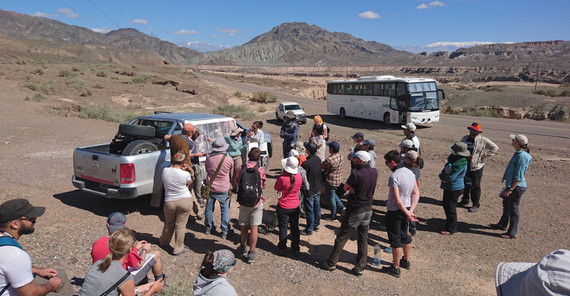On a bright sunny morning we start our fourth day in Rodeo. The wind here is so strong that almost all the trees are tilted towards the West, and we could experience that when we arrived the last evening. The strong winds at this place are also the reason why Rodeo is a famous spot for wind surfers.
We get into the bus, cross the dam of Rodeo and stop nearby to see the boundary between two old and small continents. Here, tectonic forces uplifted oceanic crust that used to be below the sea level, to an altitude of more than 1500. The lavas that constitute this crust emerged under water. Due to the contact with the cold oceanic water, they cooled down very fast and almost look like pillows. This is why geologists call them pillow-lavas. Continuing our journey, we have a closer look at solidified dunes. The existence of a 20 million year old desert at this very place tells that South America has not moved significantly from the equator since then. Due to atmospheric convection, at these latitudes it is common to find deserts. However, it is peculiar that nowadays a river is carrying a lot of water and many places are vegetated, forming a beautiful contrast to the naked mountains of the Andes. This extraordinary vegetation is attributed to the Monsoon system that is being influenced by the Andes.
For our lunch break we stop by a shrine that is dedicated to “Gauchito Gil”. In colonial times, Gil stole from the rich to give it to the poor. He literally was the Robin Hood of Argentina and a hero to the poor people. Eventually he was caught by the authorities and sentenced to death for his deeds. Many monuments dedicated to Gil exist along all the roads of Argentina, because it is believed that his spirit takes care of the drivers. To thank Gil’s spirit for his guidance, many travellers offer gifts at these shrines.
We get back into our bus and continue crossing the cordillera, heading to Jachal town. Just South of the town, both the Jachal river and the wind eroded an actively uplifting hill, leaving many v-shaped gaps in this hill. A lot of these still moving structures are responsible for the many earthquakes that affect this region. At our eastern most stop, near to Niquivil town, we see the last mountain chain of the cordillera. Here, ruins of furnaces tell that the more than 400 million year old limestones were burned by the former inhabitants to obtain the lime contained within the rocks. It is early afternoon and the sun is burning.
Our last stop of the day, just at the southern coast of the Rodeo lake. Here, we observe ten million year old soils that were recorded in the rocks. Also, petrified wood that we find along the slope tells about the climate at that time. Walking up the hill, the strong wind is blowing, making it difficult to walk. We get back into the bus, looking forward to having another bath in the hotel pool.
Text: Sara Figueroa; Sibiao Liu; Germán Aranda; Louis Desanois; Christian Meeßen
Online published by: Daniela Großmann
Contact us: onlineredaktionuuni-potsdampde
Prior journal entry
Next journal entry
Show all journal entries

